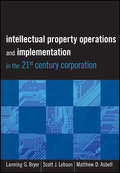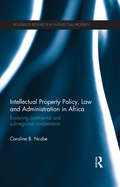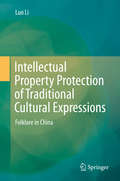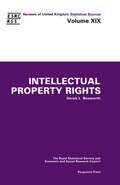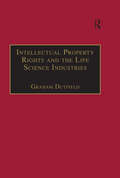- Table View
- List View
Intellectual Property Operations and Implementation in the 21st Century Corporation
by Lanning G. Bryer Scott J. Lebson Matthew D. AsbellA practical approach to corporate IP operations and implementation Intellectual Property Operations and Implementation helps executives, attorneys, accountants, managers, and owners, understand the legal, technological, economic, and cultural changes that have affected corporate IP ownership and management. Page by page, it provides practical examples and advice from seasoned and enduring professionals who have adopted new and streamlined methods and practices whether as in-house or outside counsel, or service providers. Timely and relevant in view of the substantially global economic recession amidst rampant technological development and the resulting changes in law, practice, and culture Examines the decision making processes, activities, and changes of significant corporate intellectual property owners in today's new economy Important and timely, this book provides a global approach to corporate IP management.
Intellectual Property Overlaps: A European Perspective
by Estelle Derclaye Matthias LeistnerIntellectual property rights, conventionally seen as quite distinct, are increasingly overlapping with one another. There are several reasons for this: the expansion of IPRs beyond their traditional borders, the creation of new IPRs especially at EU level, the exploitation of gaps in the law by shrewd lawyers, and the use of unfair competition as an alternative when IPRs are either not available at all or expired. The convergence of several IPRs on the same subject-matter poses problems. As they are normally envisaged as water-tight categories, there are very few rules which cater for the sort of regime clash that any overlap of IPRs necessarily entails. This book's aim is to find appropriate rules to regulate overlaps and thereby avoid regime conflicts and undue unstructured expansion of IPRs. The book studies the practical consequences of each overlap at the international, European and national levels (where the laws of France, the UK and Germany are reviewed). It then analyses the reasons for the prohibition or authorisation of overlaps. This analysis enables the determination of criteria and principles that can be used to (re)map the overlaps to achieve appropriateness and legitimacy.
Intellectual Property Perspectives on the Regulation of New Technologies (ATRIP Intellectual Property series)
by Tana PistoriusIntellectual Property Perspectives on the Regulation of New Technologies explores the challenges that emerging technologies and technology-driven practices pose for traditional notions of intellectual property (IP) law and policy. This book exposes the intimate relationship between IP and technology and demonstrates how most substantial revisions to IP law have been driven by technological innovations. Authors offer perspectives from across the intellectual property law spectrum and address questions such as: is the law evolving in the right direction?; and is the regulation of emerging technologies supported by sound policy objectives? The resulting discussion exposes the disparate manner in which IP law has responded to challenges posed by innovation and new technologies. In Part I authors explore whether the regulation of new technologies has fundamentally altered the object and purpose of IP law, including the balance of interests. Part II focuses on the impact of digital technologies, specifically on copyright law and policy. Covering a diverse range of topics, this book will be of interest to scholars who are researching the relationship between technological development and IP law and practice. It will also be a useful resource for those who have an interest in the evolving nature of IP law.
Intellectual Property Policy, Law and Administration in Africa: Exploring Continental and Sub-regional Co-operation (Routledge Research in Intellectual Property)
by Caroline B. NcubeThis book examines the harmonisation of Intellectual Property (IP) policy, law and administration in Africa. Two recent developments have brought this topic to the fore. The first is the escalation of long-standing efforts to establish a Pan-African Intellectual Property Organisation (PAIPO), a continental initiative. The second is the current sub-regional attempt to operationalise the IP provisions of the Southern African Development Community (SADC)’s Protocol on Trade (articles 9b and 24) and its Protocol on Science, Technology and Innovation (article 2m). Intellectual Property Policy, Law and Administration in Africa discusses the viability of such initiatives with particular reference to the current socio-economic status of Africa’s nations. With a view to contributing to future developments in Africa at both a continental and sub-regional level, the author considers this issue through the lens of advancing the public interest in IP. Ncube argues that harmonisation initiatives ought to be crafted in a way that is supportive of the development aspirations of African states. Consequently, she urges due consideration of individual states’ unique conditions and aspirations in any harmonisation venture, a necessity outlined in article 7 of the Agreement on Trade Related Aspects of Intellectual Property Rights. This book will be of great relevance to scholars and policy makers with an interest in IP law and African law in general.
Intellectual Property Policy, Law and Administration in Africa: Exploring Continental and Sub-regional Co-operation (Routledge Research in Intellectual Property)
by Caroline B. NcubeThis book examines the harmonisation of Intellectual Property (IP) policy, law and administration in Africa. Two recent developments have brought this topic to the fore. The first is the escalation of long-standing efforts to establish a Pan-African Intellectual Property Organisation (PAIPO), a continental initiative. The second is the current sub-regional attempt to operationalise the IP provisions of the Southern African Development Community (SADC)’s Protocol on Trade (articles 9b and 24) and its Protocol on Science, Technology and Innovation (article 2m). Intellectual Property Policy, Law and Administration in Africa discusses the viability of such initiatives with particular reference to the current socio-economic status of Africa’s nations. With a view to contributing to future developments in Africa at both a continental and sub-regional level, the author considers this issue through the lens of advancing the public interest in IP. Ncube argues that harmonisation initiatives ought to be crafted in a way that is supportive of the development aspirations of African states. Consequently, she urges due consideration of individual states’ unique conditions and aspirations in any harmonisation venture, a necessity outlined in article 7 of the Agreement on Trade Related Aspects of Intellectual Property Rights. This book will be of great relevance to scholars and policy makers with an interest in IP law and African law in general.
Intellectual Property Protection for AI-generated Creations: Europe, United States, Australia and Japan
by Ana RamalhoThis book explores the intersection between artificial intelligence and two intellectual property rights: copyright and patents. The increasing use of artificial intelligence for generating creative and innovative output has an impact on copyright and patent laws around the world. The book aims to map and analyse that impact. The author considers how artificial intelligence systems may aid, or in some cases substitute for, human creators and inventors in the creative process. It is from this angle that the copyright and patent regimes in four jurisdictions (Europe, the United States, Australia and Japan) are investigated in depth. The author describes how these jurisdictions look at works and inventions generated through a process where artificial intelligence is present or prevalent, and examines how copyright and patent regimes should adapt to the reality of artificially intelligent creators and inventors.As the use of artificial intelligence to generate creative and innovative products becomes more common, this book will be a valuable resource to researchers, academics and policy makers alike.
Intellectual Property Protection for AI-generated Creations: Europe, United States, Australia and Japan
by Ana RamalhoThis book explores the intersection between artificial intelligence and two intellectual property rights: copyright and patents. The increasing use of artificial intelligence for generating creative and innovative output has an impact on copyright and patent laws around the world. The book aims to map and analyse that impact. The author considers how artificial intelligence systems may aid, or in some cases substitute for, human creators and inventors in the creative process. It is from this angle that the copyright and patent regimes in four jurisdictions (Europe, the United States, Australia and Japan) are investigated in depth. The author describes how these jurisdictions look at works and inventions generated through a process where artificial intelligence is present or prevalent, and examines how copyright and patent regimes should adapt to the reality of artificially intelligent creators and inventors.As the use of artificial intelligence to generate creative and innovative products becomes more common, this book will be a valuable resource to researchers, academics and policy makers alike.
Intellectual Property Protection for Plant Related Innovation: Fit for Future? (Law for Professionals)
by Michael Andreas KockThe book reviews the history, present, and likely future of intellectual property for plant-related inventions. It describes “what works” and “what does not work” in the current situation and analyzes whether the current intellectual property framework will be able to cope with the rise of genome editing/new breeding technologies (especially CRISPR Cas). Based on trend data, the analysis shows that the current system, including stakeholder initiatives, will most likely not be able to adapt to the technology change. It then evaluates different options for legislators to respond and proposes in detail a new holistic IP system which merges elements of the patent and the plant variety protection system into one new system.
Intellectual Property Protection of Traditional Cultural Expressions: Folklore in China
by Luo LiThe work reviews issues concerning the protection of folklore through the intellectual property legal system, then explores two main issues in the protection of Chinese folklore. The first issue is the influence of Chinese traditional culture on the Chinese intellectual property legal system and Chinese society. The second concerns the deficiencies of the Chinese intellectual property system with regard to folklore. Both issues are examined through a survey on the weak public recognition of intellectual property law and folklore in Chinese society. The book also reveals the practical issues that have arisen in Southwest China through case studies. After analysing these issues, the work designs a model law specifically for folklore and also provides suggestions for how the current intellectual property legal system could establish a comprehensive legal protection system for folklore. Furthermore, the work shows that its proposed model law is effective in practice by resolving the issues in the case studies presented.
Intellectual Property Rights (Reviews of UK Statistical Sources (RUKSS))
by D. L. BosworthThis volume reviews the publicly available sources of statistical information on intellectual property rights, looking principally at patents, designs, royalties and inventions. The book examines the criteria against which intellectual property is measured, discussing the definitions of 'inventive activity' and 'applied research'; the differences between 'inventiveness' and 'creativity'; the meaning of originality; and the distinctions between scientific originality, industrial inventiveness and business acumen. A valuable source of information for researchers and professionals in the field.
Intellectual Property Rights and ASEAN Development in the Digital Age (Routledge-ERIA Studies in Development Economics)
by Lurong Chen Fukunari KimuraThe trade-investment-service-intellectual property (IP) nexus remains at the heart of economic development and the main features of which are global value chains (GVCs) and digitalisation. The protection of intellectual property rights (IPR) has become a critical issue not only for advanced economies but also for emerging markets. This edited volume contributes to the debates on IPR protection and economic development from the perspective of Association of Southeast Asian Nations (ASEAN) member states. The book provides insights into the mechanism and evidence on how effective IPR protection will increase economic and social welfare via promoting innovation activities and providing incentives to diffuse knowledge and transfer technologies. Written by economists and lawyers from the region, these experts share their latest findings and thoughts on how countries in Southeast Asia have been progressively improving IPR protection and increasing the interoperability of different IPR regimes through regional cooperation to facilitate business operations in the context of digital transformation.
Intellectual Property Rights and ASEAN Development in the Digital Age (Routledge-ERIA Studies in Development Economics)
by Lurong Chen Fukunari KimuraThe trade-investment-service-intellectual property (IP) nexus remains at the heart of economic development and the main features of which are global value chains (GVCs) and digitalisation. The protection of intellectual property rights (IPR) has become a critical issue not only for advanced economies but also for emerging markets. This edited volume contributes to the debates on IPR protection and economic development from the perspective of Association of Southeast Asian Nations (ASEAN) member states. The book provides insights into the mechanism and evidence on how effective IPR protection will increase economic and social welfare via promoting innovation activities and providing incentives to diffuse knowledge and transfer technologies. Written by economists and lawyers from the region, these experts share their latest findings and thoughts on how countries in Southeast Asia have been progressively improving IPR protection and increasing the interoperability of different IPR regimes through regional cooperation to facilitate business operations in the context of digital transformation.
Intellectual Property Rights and Biodiversity Conservation: An Interdisciplinary Analysis of the Values of Medicinal Plants (PDF)
by Edited by Timothy SwansonThe urgent need to ensure the conservation of biological diversity is now widely recognised, but the role of an intellectual property rights regime as an instrument for biodiversity conservation is poorly understood and often hotly debated. This volume is a detailed analysis of the economic and scientific rationales for the use of a property rights-based approach to biodiversity conservation. It discusses the justification for, and implementation of, intellectual property rights regimes as incentive systems to encourage conservation. An interdisciplinary approach is used in the book, encompassing fields of study such as evolutionary biology, chemistry, economics and legal studies. The arguments are presented using the case study of the use of medicinal plants in the pharmaceutical industry. The book will be of interest and relevance to a broad spectrum of conservationists from research students to policy makers.
Intellectual Property Rights and Competition in Standard Setting: Objectives and tensions (Routledge Research in Intellectual Property)
by Valerio TortiCompetition and intellectual property rights (IPRs) are both necessary for a market to work efficiently and to promote consumer welfare. Properly applied, intellectual property rules define a legal framework which allows undertakings to profit from their inventions. This in turn encourages competition among firms and enhances dynamic efficiency, to the benefit of consumer welfare. Standard setting represents one of the fields where the interaction between competition law and IPRs clearly comes to light. The collaborative goal of standard setting organizations (SSOs) is to adopt and promote standards that either do not conflict with anyone’s right or, if they do, are developed under condition that patents are licensed under defined terms. This book examines the tension between IPRs and competition in the standard setting field which can arise when innovators over-exploit the rights they have been granted and hold up an entire industry. The book compares EU and U.S. jurisdictions with a particular focus on the IT and telecommunication sectors. It scrutinizes those practices which could harm standard setting and its goals, looking at misleading conducts by SSOs’ members which may lead to breach the EU and U.S. antitrust provisions on abuse of market power. Recent developments in EU and U.S. standard setting are analysed highlighting the differences in enforcement approaches. The book considers how the optimal balance between IPRs and industry standards can be struck, suggesting a policy model which takes into account both innovators’ interests and SSOs’ goals.
Intellectual Property Rights and Competition in Standard Setting: Objectives and tensions (Routledge Research in Intellectual Property)
by Valerio TortiCompetition and intellectual property rights (IPRs) are both necessary for a market to work efficiently and to promote consumer welfare. Properly applied, intellectual property rules define a legal framework which allows undertakings to profit from their inventions. This in turn encourages competition among firms and enhances dynamic efficiency, to the benefit of consumer welfare. Standard setting represents one of the fields where the interaction between competition law and IPRs clearly comes to light. The collaborative goal of standard setting organizations (SSOs) is to adopt and promote standards that either do not conflict with anyone’s right or, if they do, are developed under condition that patents are licensed under defined terms. This book examines the tension between IPRs and competition in the standard setting field which can arise when innovators over-exploit the rights they have been granted and hold up an entire industry. The book compares EU and U.S. jurisdictions with a particular focus on the IT and telecommunication sectors. It scrutinizes those practices which could harm standard setting and its goals, looking at misleading conducts by SSOs’ members which may lead to breach the EU and U.S. antitrust provisions on abuse of market power. Recent developments in EU and U.S. standard setting are analysed highlighting the differences in enforcement approaches. The book considers how the optimal balance between IPRs and industry standards can be struck, suggesting a policy model which takes into account both innovators’ interests and SSOs’ goals.
Intellectual Property Rights and Competition Law in India (Routledge Research in Intellectual Property)
by Rajni Malhotra Dhingra Nisha Dhanraj DewaniThis book explores the relationship between intellectual property law and competition law, proposing a harmonious equilibrium in the dynamic landscape of evolving technology. It explores how intellectual property rights (IPR) can be effectively balanced with competition law considerations, offering insights into navigating the evolving intersection of legal frameworks in the realm of technology and innovation.In the rapidly evolving landscape of India's legal framework, the intersection of IPR and competition law has become a critical focal point. This book dissects the regulatory landscape, offering a thorough analysis of India's competition law and its application in conjunction with patent, copyright, trademark, blockchain technologies, computer software, artificial intelligence, and more. Covering landmark legal decisions, precedents, and emerging trends that shape the balance between fostering innovation and preventing anticompetitive practices, the book also uses case studies involving WhatsApp Vs. CCI and Vidya Drolia case. Focusing on India, but with lessons for a global audience, the book brings together contributions from experts across disciplines, to promote innovative solutions to balancing IP and competition law with technological advancements.The book will be of interest to researchers in the field of the law of emerging technologies, IP law, and competition law.
Intellectual Property Rights and Competition Law in India (Routledge Research in Intellectual Property)
This book explores the relationship between intellectual property law and competition law, proposing a harmonious equilibrium in the dynamic landscape of evolving technology. It explores how intellectual property rights (IPR) can be effectively balanced with competition law considerations, offering insights into navigating the evolving intersection of legal frameworks in the realm of technology and innovation.In the rapidly evolving landscape of India's legal framework, the intersection of IPR and competition law has become a critical focal point. This book dissects the regulatory landscape, offering a thorough analysis of India's competition law and its application in conjunction with patent, copyright, trademark, blockchain technologies, computer software, artificial intelligence, and more. Covering landmark legal decisions, precedents, and emerging trends that shape the balance between fostering innovation and preventing anticompetitive practices, the book also uses case studies involving WhatsApp Vs. CCI and Vidya Drolia case. Focusing on India, but with lessons for a global audience, the book brings together contributions from experts across disciplines, to promote innovative solutions to balancing IP and competition law with technological advancements.The book will be of interest to researchers in the field of the law of emerging technologies, IP law, and competition law.
Intellectual Property Rights and Emerging Technology: 3D Printing in China
by Hing Kai Chan Hui Leng Choo Onyeka Osuji James Griffin3D printing poses many challenges to the traditional law of intellectual property (IP). This book develops a technical method to help overcome some of these legal challenges and difficulties. This is a collection of materials from empirical interviews, workshops and publications that have been carried out in one of the world's leading research projects into the legal impact of 3D printing. The project was designed to establish what legal challenges 3D printing companies thought they faced, and having done that, to establish a technical framework for a solution.
Intellectual Property Rights and Emerging Technology: 3D Printing in China
by Hing Kai Chan Hui Leng Choo Onyeka K. Osuji James Griffin3D printing poses many challenges to the traditional law of intellectual property (IP). This book develops a technical method to help overcome some of these legal challenges and difficulties. This is a collection of materials from empirical interviews, workshops and publications that have been carried out in one of the world's leading research projects into the legal impact of 3D printing. The project was designed to establish what legal challenges 3D printing companies thought they faced, and having done that, to establish a technical framework for a solution.
Intellectual Property Rights and the EC Competition Rules
by Valentine KorahThis latest monograph by Professor Korah on the recent group exemption consists of a detailed and critical commentary on the technology transfer block exemption and guidelines of 2004, and of the case law of the ECJ and Commission on licensing and refusals to license, together with annotated copies of the regulation and guidelines. There is a substantial chapter on refusal to supply or license in the light of the recent case law under Article 82. It embraces many of the competition issues that may affect intellectual property rights. After a brief introduction, the work starts with short chapters on the free movement of goods and services, the status of the Commission's guidelines and the historically hostile attitude of the Commission under Article 81 towards licensing. It then launches into a detailed analysis of the regulation and the probable treatment of licences that do not fall within it. Throughout the book the author provides extensive analysis of policy and economics as well as comparison with US practice.
Intellectual Property Rights and the Life Science Industries: A Twentieth Century History (Globalization and Law)
by Graham DutfieldThis book analyses the history of the international patent regime and the life science industries, both of which can be traced back to the late 19th century. The development of patent law is inextricably linked to expanding capacities to elucidate, manipulate and commercially exploit the molecular properties of micro-organisms, plants, animals and other organic raw materials. The story of the life science industries begins with the European synthetic dyestuff firms and culminates in present-day conglomerates like Aventis, Novartis and Pharmacia. Throughout the last century, chemical, pharmaceutical, seed and biotechnology firms were actively involved in reforming patent law and plant variety rights. The major beneficiaries have been the largest firms whose market dominance and influence over peoples' lives - aided by friendly intellectual property laws - has never been greater. This sparkling and stimulating book reveals the key repercussions caused by the expansion of life science industries for issues of international equity, public health, food security and biological diversity.
Intellectual Property Rights and the Life Science Industries: A Twentieth Century History (Globalization and Law)
by Graham DutfieldThis book analyses the history of the international patent regime and the life science industries, both of which can be traced back to the late 19th century. The development of patent law is inextricably linked to expanding capacities to elucidate, manipulate and commercially exploit the molecular properties of micro-organisms, plants, animals and other organic raw materials. The story of the life science industries begins with the European synthetic dyestuff firms and culminates in present-day conglomerates like Aventis, Novartis and Pharmacia. Throughout the last century, chemical, pharmaceutical, seed and biotechnology firms were actively involved in reforming patent law and plant variety rights. The major beneficiaries have been the largest firms whose market dominance and influence over peoples' lives - aided by friendly intellectual property laws - has never been greater. This sparkling and stimulating book reveals the key repercussions caused by the expansion of life science industries for issues of international equity, public health, food security and biological diversity.
Intellectual Property Rights as Obstacles to Legitimate Trade?
by Christopher Heath, Anselm Kamperman Sanders and Anke MoerlandIntellectual Property Rights as Obstacles to Legitimate Trade helps to understand one of the underlying rationales of the TRIPS Agreement in light of some of the most pertinent IP issues. The WTO/TRIPS Agreement for the first time put IP rights in the context of trade rules, such as when does the exercise of IP rights become an unjustified burden to legitimate trade? Cases have arisen where IP rights are conferred, used, or enforced in a manner that arguably impedes trade, both in domestic and international contexts. This groundbreaking book is the first comprehensive assessment of this controversial area of trade law, shedding important new light on the underlying rationales of the TRIPS Agreement. With contributions by both practitioners and academics working in a range of countries, this book considers thorny issues in such areas as the following: – interpretation of ‘obstacles to legitimate trade’ in the context of GATT/ WTO jurisprudence; – separating markets by preventing parallel importation in the context of patents; – geoblocking – territorial separation of digital markets; – using trademarks to prevent competition; – geographical indications – protection of terms that are considered generic in certain domestic markets; – seizure of goods in transit; – ‘evergreening’ patents – attempts to extend the duration of patents; – rights to second-hand digital goods or content; – unjustified threats – towards appropriate standards of liability. Focusing on topical and under-researched areas of IP law, the contributors stimulate a discussion on an overarching concern that is not often addressed – how to assess whether the protection and enforcement of certain IP rights in particular situations should be classified as trade barriers. As an incisive analysis of the desirable balance between the exercise of IP rights and the demands of legitimate trade, this book will be welcomed by practitioners, lawmakers, policy advisers, and academics in both trade law and IP law.
Intellectual Property Rights, Copynorm and the Fashion Industry: A Comparative Analysis
by Marlena JankowskaThis book traces the development of the fashion industry, providing insight into the business and, in particular, its interrelations with copyright law. The book explores how the greatest haute couture fashion designers also had a sense for business and that their attention to copyright was one of the weapons in protecting their market position. The work also confronts the peculiarities of the fashion industry as a means of demonstrating the importance of intellectual property protection while pointing out the many challenges involved. A central aim is to provide a copyrightability test for fashion goods based on detailed analysis of the legal regulations in the USA and EU countries, specifically Italy, France, the Netherlands, Germany and Poland. The book will be of interest to researchers and academics working in the areas of Intellectual Property Law, Copyright Law, Business Law, Fashion Law and Design.
Intellectual Property Rights, Copynorm and the Fashion Industry: A Comparative Analysis
by Marlena JankowskaThis book traces the development of the fashion industry, providing insight into the business and, in particular, its interrelations with copyright law. The book explores how the greatest haute couture fashion designers also had a sense for business and that their attention to copyright was one of the weapons in protecting their market position. The work also confronts the peculiarities of the fashion industry as a means of demonstrating the importance of intellectual property protection while pointing out the many challenges involved. A central aim is to provide a copyrightability test for fashion goods based on detailed analysis of the legal regulations in the USA and EU countries, specifically Italy, France, the Netherlands, Germany and Poland. The book will be of interest to researchers and academics working in the areas of Intellectual Property Law, Copyright Law, Business Law, Fashion Law and Design.
